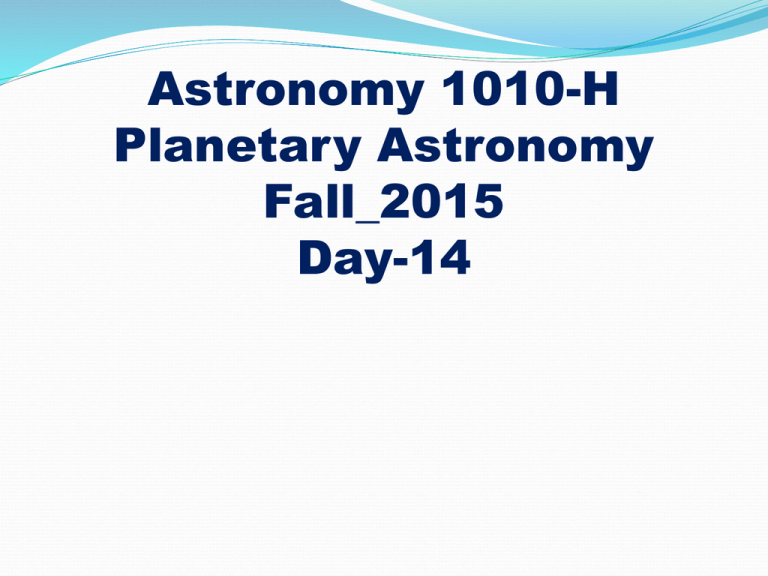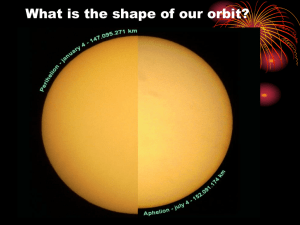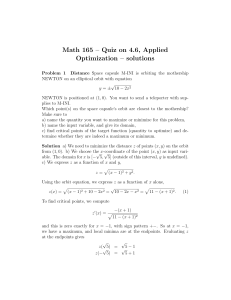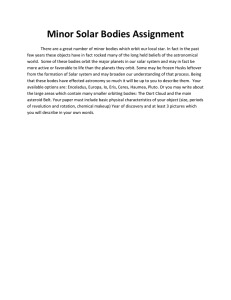Astronomy 1010-H Planetary Astronomy Fall_2015 Day-14
advertisement

Astronomy 1010-H Planetary Astronomy Fall_2015 Day-14 Course Announcements • How is the sunset/sunrise observing going? • Dark Sky nights – Mon. 10/5 & Wed. 10/7 starting at 7:30pm – at the Observatory. • Total lunar eclipse: Sun.-Mon. 9/27-28 • • • Weather dependent, if clear, we’ll be setup at the observatory about sunset. Here’s the important information I will collect the L-T workbooks TODAY. • Make sure your name is in it. Kepler’s Third Law The size of the orbit determines the orbital period planets that orbit near the Sun orbit with shorter periods than planets that are far from the Sun 3 a = AU 2 P years Lecture – Tutorial rd Kepler’s 3 Law: pg 25 Work with a partner! Read the instructions and questions carefully. Discuss the concepts and your answers with one another. Come to a consensus answer you both agree on. If you get stuck or are not sure of your answer, ask another group. If you get really stuck or don’t understand what the Lecture Tutorial is asking, ask one of us for help. Which of the following best describes what would happen to a planet’s orbital speed if it’s mass were doubled but it stayed at the same orbital distance? A. It would orbit half as fast. B. It would orbit less that half as fast. C. It would orbit twice as fast. D. It would orbit more than twice as fast. E. It would orbit with the same speed. If a small weather satellite and the large International Space Station are orbiting Earth at the same altitude above Earth’s surface, which of the following is true? A. The large space station has a longer orbital period. B. The small weather satellite has a longer orbital period. C. Each has the same orbital period CONNECTIONS 3.1 Copernicus was able to use right-triangle trigonometry and observations of planets at opposition or conjunction to very accurately find their distances relative to the Earth–Sun distance. CONNECTIONS 3.1 These distances were very accurate compared to our modern values. He was not able to discern our distance from the Sun this way, so the distances are expressed in units of our distance (1 AU). MATH TOOLS 3.1 The synodic (S) and sidereal (P) periods of the planets can be related to Earth’s (E) sidereal period (365.25 days). Inferior planets: Superior planets: Synodic periods are measurable from Earth. MATH TOOLS 3.2 Kepler’s third law in its simplest form utilizes nonstandard units—the periods are in years, while the distances are in AU. The relationship does not change if standard units are used. The equation is just more complicated. MATH TOOLS 3.3 Proportionality and inverse proportionality are ways to understand how one quantity behaves relative to another quantity. It lets you get the gist of how the relationship works between those two quantities. Sometimes, you need to know more than just the gist—you need to know the constant of proportionality, which exactly relates the quantities. Galileo Galilei was the first scientist to observe the sky with a telescope. Found four moons in orbit around Jupiter. Saw that Venus had phases. • In a geocentric model, Venus’s phase would not change. Isaac Newton (1642 – 1727) The Baddest Dead White Guy of Them All Isaac Newton (1642 – 1727) 1. Probably died a virgin 2. Was a priest and Lawyer 3. Had artificial wooden and silver noses 4. Probably died of Mercury poisoning 5. Rumored to have died when his bladder burst 6. Was blind at the time of his death 7. Was labelled a heretic by the church Isaac Newton (1642 – 1727) 1. 2. 3. 4. 5. 6. 7. Probably died a virgin Was a priest and Lawyer Had artificial wooden and silver noses Probably died of Mercury poisoning Rumored to have died when his bladder burst Was blind at the time of his death Was labeled a heretic by the church Using observations and investigations from Galileo, Isaac Newton discovered laws that apply to all objects. Basis of classical mechanics. Physical laws, not empirical science. Newton’s First Law of Motion • A body remains at rest or moves in a straight line at a constant speed unless acted upon by an outside (net) force. • A rockets will coast in space along a straight line at constant speed. • A hockey puck glides across the ice at constant speed until it hits something Newton’s Second Law of Motion • (net)Force = mass x acceleration or Fnet = m x a • Acceleration is the rate of change in velocity – or how quickly your motion is changing. • Three accelerators in your car!! Acceleration is force divided by mass, or a F m Mass resists changes in motion. Greater forces mean greater accelerations. MATH TOOLS 3.3 Proportionality and inverse proportionality are ways to understand how one quantity behaves relative to another quantity. It lets you get the gist of how the relationship works between those two quantities. Sometimes, you need to know more than just the gist—you need to know the constant of proportionality, which exactly relates the quantities. MATH TOOLS 3.4 Knowing the unbalanced force an object experiences allows you to find its acceleration, and vice versa. Newton’s Third Law of Motion • Whenever one body exerts a force on a second body, the second body exerts an equal and opposite force on the first body. • Don’t need a rocket launch pad! • The Bug and the Windshield – who is having the worse day? Newton’s third law of motion: For every force, there is an equal and opposite force. The two forces have the same size. The two have opposite directions.


